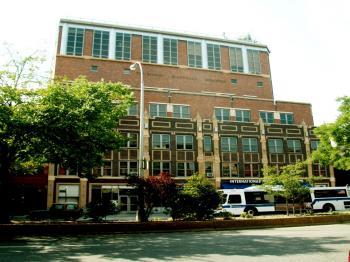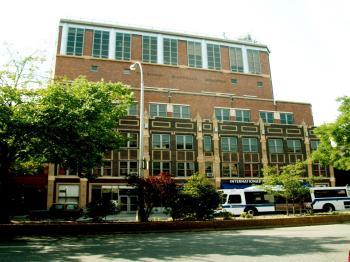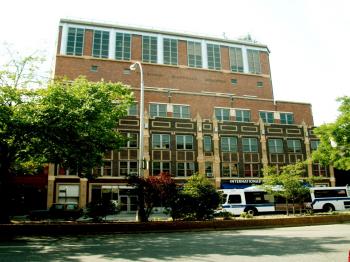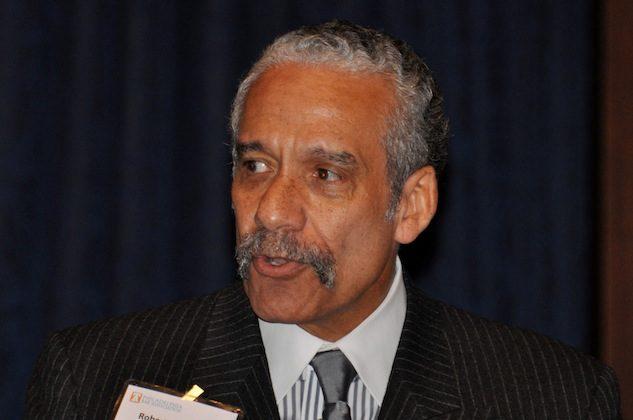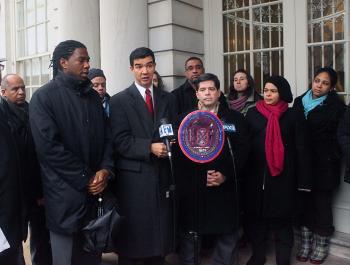Harlem has its challenges. The area has been dogged with crime, AIDS, and economic depression over the years—sometimes all at once. In 1989, the Abyssinian Development Corporation (ADC) formed with the hope of addressing the roots of these issues. The founders’ wish was to rebuild a strong, self-sufficient community.
President and CEO of the corporation, Sheena Wright, sat down with The Epoch Times to share her insights along with her passion of working with the people of Harlem throughout the years.
The 202-year-old church, which still stands as a landmarked building, was founded by a group of Ethiopian merchants in response to discriminatory practices against people of color. Its social justice mandate continued as the community met challenges over the decades.
During the 1920s and 30s, a large population moved to Harlem. “That was the epicenter of great migration when black people from all over the country, [from] all over the world, came to Harlem,” Wright said. It was the Harlem renaissance, with flourishing businesses making the community an international Black cultural and economic capital.
President and CEO of the corporation, Sheena Wright, sat down with The Epoch Times to share her insights along with her passion of working with the people of Harlem throughout the years.
Harlem’s History
The ADC was established just over 20 years ago, but its roots into the community reach back more than 200 years, with the founding of the Abyssinian Church in the depths of slavery.The 202-year-old church, which still stands as a landmarked building, was founded by a group of Ethiopian merchants in response to discriminatory practices against people of color. Its social justice mandate continued as the community met challenges over the decades.
During the 1920s and 30s, a large population moved to Harlem. “That was the epicenter of great migration when black people from all over the country, [from] all over the world, came to Harlem,” Wright said. It was the Harlem renaissance, with flourishing businesses making the community an international Black cultural and economic capital.
By the time of the Great Depression however, with the population having grown significantly, the community was hard hit. Over the next few decades, the community would continue to struggle. Disinvestment in the cities to create suburban communities in the 1940s and 50s presented another challenge as well as the national policy of red-lining around communities of people of color, which halted loans—decreasing resident’s ability to buy homes and businesses.
“In the 70s, you had the fiscal crisis where New York was on the brink of bankruptcy,” Wright said. “In the 80s you had AIDS as this new disease that was really devastating to our communities—crack as a new epidemic on top of what had come before, which was heroin. By the time the Development Corporation formed, it was a very challenged community.”
Wright describes the economic opportunities in Harlem at that time as “depressed.” She said 60 percent of the housing in the community was owned by the city because landlords had completely walked away, saying it wasn’t worth anything. “That’s where our work begins in the community,” she said.
Looking for Opportunities
By 1989, the year the ADC was formed, there was “nothing in central Harlem. No commercial development and no major retailers present in the community,” she said, noting that the landscape was comprised of vacant and abandoned buildings in disrepair, and rampant crime.Despite the disheartening situation, Wright said the corporation saw its strengths.
“We said: ‘In this devastation and challenge and all these terrible things, there are some good things and let’s figure out what those are. Let’s build on those and create the neighborhood that we want for ourselves, for our children, that we expect,’” she said.
In 1989, a group of parents, business leaders, and parishioners from the church came up with a mission statement highlighting a series of elements to get the community back on track.
The first mission was to create quality housing for people of diverse incomes. “It doesn’t say ‘affordable,’ it says ‘quality,’” says Wright. “You need a mix of income in order to create successful, sustainable communities. You can’t have 100 percent low-income communities and expect them to be successful.”
To date, ADC has between 1,300 to 1,400 housing units and has created home ownership opportunities, along with other community development corporations in Harlem.
Building the Economic Engine
Wright says that what the founders saw as core to the success of the community was having a strong economic base. “If you don’t have an economic engine, you don’t have a community that can grow, thrive, and develop,” she said.With this in mind, ADC worked with every level and size of business to bring the first major commercial development in Harlem in half a century—the Pathmark supermarket. Wright says there was a great need for the service and locals demanded it. They wanted an alternative to having to take the train or bus out of their community just to buy groceries.
Despite the great demand however, Wright said that the project met with a great amount of opposition from many levels of the community. “It was a big struggle to bring it here.”
The corporation bought a one-block-long property from the city. It had been abandoned and was in a desolate condition.
Many small businesses, like bodega owners, argued fiercely against the project—claiming that a big supermarket was a sure way to put them out of business.
Meanwhile, the supermarket management also expressed doubt as to whether they could make any profit in a market where the surrounding population was economically depressed. ADC fought hard to go ahead with the project, saying that this is what the community needed.
“What we were trying to demonstrate is that the expenditure potential in an inner-city that is economically challenged is enormous,” Wright said. “Bring these goods and services to these communities and you will get a huge return. They didn’t believe it and it was a fight. After much blood, sweat, and tears, we opened up this Pathmark. It was the highest grossing one in the trade, and it really set the stage for looking at inner cities as these viable commercial centers for these major retailers.”
Such was the success that even today; Wright says the Harvard Business School continues to teach a case study on the opening of the supermarket.
Wright said that in addition to the larger chains, ADC made it a priority to focus on some of the largest creators of jobs in the community—small businesses. They created a small business loan fund, providing small, low-interest loans to local businesses, as well as instituting a franchise program linking local entrepreneurs to various franchises.
ADC also looked at the workforce. They created a youth build program for young people who had dropped out of high school, helping them get their GED as well as offering training in different trades.
Educating Harlem’s Kids
Education has also been a cornerstone of the corporation. ADC developed three educational institutions including the Thurgood Marshall Academy for Learning and Social Change, the first new high school built in Harlem in 50 years, as well as the Abyssinian Head Start and Thurgood Marshall Academy Lower School.“Because we’re developers,” Wright said, “we also appreciate the appropriate facilities in delivering the educational opportunities.”
The corporation owns the building, and the school has been ranked very high in terms of test scores.
Vulnerable Residents
In addition to education, ADC decided at its inception to focus on some of the most vulnerable members of the community such as seniors and the homeless. They created a homeless shelter as well as housing for seniors. Wright said that as the population ages, many seniors continue to live in buildings that don’t meet their needs.Lastly, Wright emphasized the importance of advocacy and policy to the work they are doing. “Whether it’s creating tenant associations, block associations, neighborhood leadership groups, working with our local officials in city hall, Washington D.C., or Albany, we believe it’s critically important to be at the table for all of those conversations and decisions, because they will impact you on the ground,” says Wright.
ADC Today
After many years, Wright says Harlem is currently facing a different set of circumstances and challenges than at the beginning.“Twenty plus years ago, it was trying to rebuild, and now it’s about gentrification and challenges around preventing displacement of low and moderate income families,” she said.
In this challenging economic climate, the community is increasingly looking towards ADC, Wright said. “More people are looking for us to fill in the gaps in terms of service opportunities, which we’re not always able to do because there’s only so much that one institution can do.”
She notes that many condos developed over the past five years are now empty, with people unsure of the future prospects. The subsidies for a lot of affordable housing developed 10 or 20 years ago are now due to expire, with many units being sold to for profit developers to become market rate housing.
“I think it’s a defining moment for Harlem,” Wright said. “There’s a lot of influx, and I think there’s a large expectation from the community that we will provide a lot of the answers to a lot of the challenges.”
She said part of what has made ADC different from other developers has been their longstanding presence in the neighborhood. “We’re not going anywhere, so when we look at a vacant lot, we don’t think of what we’re going to generate from this box, we think about what kind of impact it’s going to have on this neighborhood over the next 50 years because we’re going to be here.”
“It’s about developing a community as opposed to developing a real estate project,” she said.
With so many initiatives and departments under its umbrella, Wright said she finds the diversity of what ADC is doing most rewarding.
“When we think about all these different business units: real estate, education, business etc, it’s all about the people, the family, and the individuals in the community—the human element.”
Seeing how one piece will influence all the others in unique ways is quite exciting, she said. “I’m never bored.”
